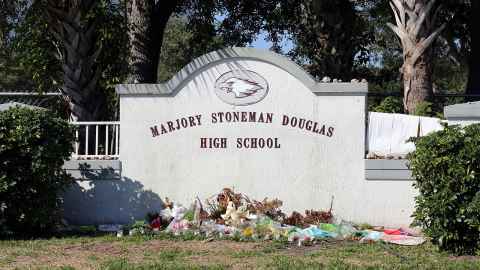School attacks and white nationalists
1 December 2020
Opinion: A scare about a potential school shooting in Wellington highlights the risks of online radicalisation of young people, writes Lauren Currid and Chris Wilson.

On the morning of November 26, Wellington High School was placed into a lockdown after police received evidence of a planned school shooting. The would-be shooter’s Instagram page included photographs of the Australian terrorist who attacked two mosques in Christchurch, and of a rifle and a hand holding bullets.
The individual referred to themselves as a Nazi. The convergence of white nationalist ideology and school shooting may seem like an unhappy coincidence. However, our current research into lone actor mass violence has found there are striking similarities between the perpetrators of school shootings and white nationalist attacks. Indeed, it is sometimes difficult to differentiate between the two.
New Zealand has only experienced one school shooting in recorded history. The Waikino School shooting in October 1923 left two children dead and six wounded. Comparatively, school shootings in the United States have become commonplace.
In the first six months of 2018, the US averaged more than one school shooting per week. For 2019, there were 47 incidents in which at least one person was injured or killed as a result of a school shooting.
Studies of these attacks have painted a reasonably clear picture of their perpetrators’ profiles and the reasons for their attacks. School shooters are mostly young (15-20 years), white, and male. A 2016 study found that up to 71 percent experienced mental health issues.
Their attacks are often triggered by a stressful event, including academic failure, a relationship breakup or the death of a loved one. School shooters tend to grow up in homes with physical violence, drug abuse, and legal troubles and many try to commit suicide during their attack, with studies finding approximately 67 percent succeed.
White nationalist extremists were responsible for three times as many deaths as Islamic extremists in the United States over the past decade. In 2019, they were responsible for 81 percent of deaths from extremist attacks on American soil. Researchers have identified a string of common characteristics for these perpetrators, who, like school shooters, generally act alone.
They are mostly white males between the ages of 28 and 34 and many have faced difficulties with employment, with 36 percent unemployed. This seems to be a cause of significant stress, followed by a lack of romantic or sexual relationships.
More than half experience difficulties with their mental health, a rate three times higher than the general US male population. Despite this, white nationalists have a much lower suicide rate than school shooters (and other extremists such as so-called involuntary celibates or incels), with only 45 percent taking their own lives. This is because white nationalists often believe their actions will inspire a ‘race war’ and a return to white dominance.
There are therefore significant similarities between the profiles of school shooters and white nationalist lone actors. Both are dominated by white males, have high rates of psychological disturbance or mental health problems, and are triggered by similar stressful experiences.
In fact, the similarities go even deeper. Many school shooters are drawn to ideologies of power, such as Nazism and Stalinism, which exercise the control they so badly want in their own lives. In an ongoing study currently conducted by the authors, 28 percent of school shooters were interested in Nazi ideology and 17 percent were white nationalists.
The perpetrators of some school attacks, such as that in Trollhattan, Sweden in 2015, have explicitly targeted minority students. The Stoneman Douglas High School perpetrator, for example, carved a swastika on his gun and left a trail of racist statements online before the attack.
Both school shooters and white nationalists are now radicalised online, with unregulated forums such as Gab and 8kun (formerly 8chan) serving as a haven for violent extremist ideas. While white nationalists are much more likely to have been in some contact with an extremist organisation, the young men who go on to commit both forms of mass violence inhabit the same forums and are subject to the same vortex of racist, misogynistic and extremist memes, jokes and dialogue.
It is here, and on more open forms of social media, where both types of perpetrators often ‘leak’ their violent intentions and hold their final interactions with their online community.
Through these forums and other forms of media, both school shooters and white nationalists also come to admire, revere and aspire to mimic previous perpetrators of mass violence. For both types, more than 80 percent were inspired by and wanted to copy a previous assailant. Each group has its most high profile and infamous examples, such as the Norway 2011 and Christchurch 2019 attackers for white nationalists and the Columbine perpetrators for school shooters.
Given these connections, we believe it is crucial to now consider the two forms of mass violence not as different phenomena but as often closely linked and overlapping. If police and other security agencies are to prevent such attacks, they must recognise their similar profiles and radicalisation processes, including the similar ideologies, inspirations and triggering events.
New forms of media now mean society is increasingly polarised, but they also mean those prone to mass violence now have much more in common.
Lauren Currid is a Master of Conflict and Terrorism Studies student and Dr Chris Wilson is programme director for the programme in the Faculty of Arts.
This article reflects the opinion of the author and not necessarily the views of the University of Auckland.
Used with permission from Newsroom School attacks and white nationalists 1 December 2020.
Media queries
Alison Sims | Research Communications Editor
DDI 09 923 4953
Mob 021 249 0089
Email alison.sims@auckland.ac.nz